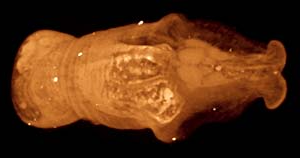Shieldfoots
| Shieldfoots | ||||||||||||
|---|---|---|---|---|---|---|---|---|---|---|---|---|

The front part of a shield- footed ( Falcidens sp.). Stained with osmium tetroxide and embedded in resin for examination by electron microscopy. |
||||||||||||
| Systematics | ||||||||||||
|
||||||||||||
| Scientific name | ||||||||||||
| Caudofoveata | ||||||||||||
| Boettger , 1955 | ||||||||||||
| Orders | ||||||||||||
|
The shield-feet (Caudofoveata, also known as Chaetodermomorpha) are, depending on the system, a class or a subclass of the molluscs (Mollusca).
The animals live in the upper layer of soft seabeds. With a few exceptions, they are shorter than 3 cm. The head with the radula of the animals is stuck in the sea floor , while the rear end with the gills protrudes into the open water. The ciliate lamellae of the gills are protected by long aragonite needles.
They owe their name to a footplate in the area of the mouth , which they use for digging. This shield is equipped with various sense organs and thus also serves as a sensory plate. Their food, which they take from the sediment, consists of detritus (breakdown substances), foraminifera (Foraminifera) and diatoms (Bacillariophyta).
Shield pods are separate sexes and release their gametes (eggs and sperm) into the open water, where fertilization takes place. Very little is known about the development of animals.
There are at least three families ( Chaetodermatidae , Limifossoridae , Prochaetodermatidae ) with about nine genera and about 60 species.
literature
- Klaus-Jürgen Götting: Caudofoveata, Schildfüßer In: Westheide, Rieger (Hrsg.): Special Zoology Part 1: Protozoa and invertebrates. Gustav Fischer Verlag, Stuttgart, Jena 1997; Pages 285-286.